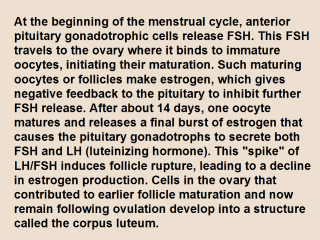 |
This structure
becomes a center for the synthesis of progesterone, a molecule that both
inhibits pituitary LH production, and promotes the growth of the uterus. In
the absence of fertilization, the corpus luteum involutes, leading to a
period of menses with low circulating estrogen and progesterone levels. The
lack of these two hormones is a positive signal for new FSH release and the
start of a new cycle. Although estrogen is the primary stimulus for the "LH
spike", gonad-produced inhibin is believed to limit the amount of FSH
released during this spike, thus fine-tuning the response. In addition,
during the luteal or post-ovulation period, ovarian-derived inhibin levels
rise, helping to suppress pituitary FSH release during this time. Then when
inhibin levels fall late in the menstrual cycle, an impediment to FSH
production is removed.
|
